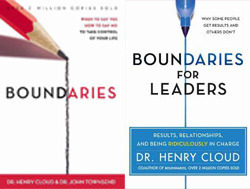Henry Cloud's Blog, page 31
June 20, 2014
Boundaries Bestseller $5.00 Special!
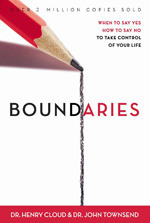 We’re excited to announce that Boundaries made several recent bestseller lists!
We’re excited to announce that Boundaries made several recent bestseller lists!
#28 on the July, 2014 CBA Christian Living Bestseller List.
#26 on the June, 2014 CBA Christian Living Bestseller List.
#23 on the April, 2014 ECPA Top 25 Bestseller List.
We know that these achievements aren’t possible without the support of fans like you buying books for friends and spreading word of mouth! We appreciate all that you do!!
To say thanks, we’ve got an unbelievable deal at ChristianBook.com. For a limited time, get the Boundaries paperback book for only $5.00 – that’s 67% off the regular price! The best way we can show our gratitude is to help save you money.
Click here to purchase Boundaries for just $5.00
The post Boundaries Bestseller $5.00 Special! appeared first on Boundaries Books.
June 19, 2014
Dr. John Townsend Discusses Boundaries in the Workplace
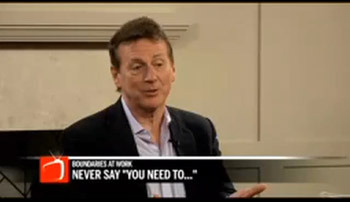 During a recent visit to Dallas, TX, Dr. John Townsend was a guest on “The Broadcast” television program to discuss “Boundaries in the Workplace.” Enjoy this insightful video interview as Dr. Townsend explains how employees and employers can set healthy boundaries to improve productivity and workplace relationships.
During a recent visit to Dallas, TX, Dr. John Townsend was a guest on “The Broadcast” television program to discuss “Boundaries in the Workplace.” Enjoy this insightful video interview as Dr. Townsend explains how employees and employers can set healthy boundaries to improve productivity and workplace relationships.
Click here to watch the video.
If a lack of boundaries is causing problems at your job, get a copy of these sanity-saving resources:
The post Dr. John Townsend Discusses Boundaries in the Workplace appeared first on Boundaries Books.
June 15, 2014
How to Forgive When It’s Hard to Forget
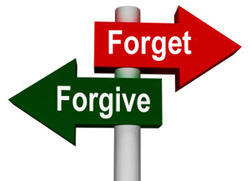 “I know I’m supposed to forgive,” a woman to me (Dr. Cloud) at a recent seminar. “But, I just can’t open myself up to that kind of hurt anymore. I know I should forgive him and trust him, but if I let him back in, the same thing will happen, and I can’t go through that again.”
“I know I’m supposed to forgive,” a woman to me (Dr. Cloud) at a recent seminar. “But, I just can’t open myself up to that kind of hurt anymore. I know I should forgive him and trust him, but if I let him back in, the same thing will happen, and I can’t go through that again.”
“Who said anything about ‘trusting’ him?” I asked. “I don’t think you should trust him either.”
“But you said I was supposed to forgive him, and if I do that, doesn’t that mean giving him another chance? Don’t I have to open up to him again?”
“No, you don’t,” I replied. “Forgiveness and trust are two totally different things. In fact, that’s part of your problem. Every time he’s done this, he’s come back and apologized, and you have just accepted him right back into your life, and nothing has changed. You trusted him, nothing was different, and he did it again. I don’t think that’s wise.”
“Well,” she asked, “How can I forgive him without opening myself up to being hurt again?”
Good question. We hear this problem over and over again. People have been hurt, and they do one of two things. Either they confront the other person about something that has happened, the other person says he’s sorry, and they forgive, open themselves up again, and blindly trust. Or, in fear of opening themselves up again, they avoid the conversation altogether and hold onto the hurt, fearing that forgiveness will make them vulnerable once again.
How do you resolve this dilemma?
The simplest way to help you to organize your thoughts as you confront this problem is to remember three points:
1. Forgiveness has to do with the past. Forgiveness is not holding something someone has done against her. It is letting it go. It only takes one to offer forgiveness. And just as God has offered forgiveness to everyone, we are expected to do the same (see Matthew 6:12 and 18:35).
2. Reconciliation has to do with the present. It occurs when the other person apologizes and accepts forgiveness. It takes two to reconcile.
3. Trust has to do with the future. It deals with both what you will risk happening again and what you will open yourself up to. A person must show through his actions that he is trustworthy before you trust him again (see Matthew 3:8; Proverbs 4:23).
You could have a conversation that deals with two of these issues, or all three. In some good boundary conversations, you forgive the other person for the past, reconcile in the present, and then discuss what the limits of trust will be in the future. The main point is this: Keep the future clearly differentiated from the past.
As you discuss the future, you clearly delineate what your expectations are, what limits you will set, what the conditions will be, or what the consequences (good or bad) of various actions will be. As the proverb says, “A righteous man is cautious in friendship” (see Proverbs 12:26). Differentiating between forgiveness and trust does a number of things:
First, you prevent the other person from being able to say that not opening up again means you are “holding it against me.”
Second, you draw a clear line from the past to the possibility of a good future with a new beginning point of today, with a new plan and new expectations. If you have had flimsy boundaries in the past, you are sending a clear message that you are going to do things differently in the future.
Third, you give the relationship a new opportunity to go forward. You can make a new plan, with the other person potentially feeling cleansed and feeling as though the past will not be used to shame or hurt him. As a forgiven person, he can become an enthusiastic partner in the future of the relationship instead of a guilty convict trying to work his way out of relational purgatory. And you can feel free, not burdened by bitterness and punitive feelings, while at the same time being wise about the future.
 Take the next step: Does offering forgiveness, learning to trust again, and setting boundaries cause confusion in your relationships? Get practical answers you can apply immediately in the bestselling book, Boundaries.
Take the next step: Does offering forgiveness, learning to trust again, and setting boundaries cause confusion in your relationships? Get practical answers you can apply immediately in the bestselling book, Boundaries.
Blog image courtesy of Stuart Miles at FreeDigitalPhotos.net
The post How to Forgive When It’s Hard to Forget appeared first on Boundaries Books.
June 12, 2014
Watch 14 “Boundaries” Teaching Videos for Free!
Thousands of people visit the Boundaries Books website each month to take the Boundaries Quiz, buy the bestselling books, and get helpful advice. However, many visitors may not be aware that we offer over a dozen free teaching videos by the Boundaries co-authors, Dr. Henry Cloud and Dr. John Townsend. These are really good videos, and we want everyone to enjoy them!
Plus, we just added four new videos that cover a wide range of topics:
Boundaries Video Chat with Dr. John Townsend
Beyond Boundaries Webcast with Dr. John Townsend
Boundaries Interview with Dr. Henry Cloud and Dave Ramsey
Boundaries for Leaders Conversation between Dr. Henry Cloud and Chick-Fil-A president, Dan Cathy
We encourage you to take a few minutes and watch these videos. You’ll enjoy expert advice about how to set boundaries in several kinds of relationships, including family, marriage, dating, and the workplace.
Click here to visit our Videos page, and please share these free videos with your friends, family, and small group members!
The post Watch 14 “Boundaries” Teaching Videos for Free! appeared first on Boundaries Books.
June 8, 2014
You Can’t Always Get What You Want – But You’d Better Try
 Telling other people what you want is key to feeling alive in a relationship and keeping things vibrant for both people. If only one person is getting his or her desires met, the relationship suffers. Unfortunately, many people do not get what they want in a relationship. But, they could if they knew how to communicate their desires.
Telling other people what you want is key to feeling alive in a relationship and keeping things vibrant for both people. If only one person is getting his or her desires met, the relationship suffers. Unfortunately, many people do not get what they want in a relationship. But, they could if they knew how to communicate their desires.
For example, Peter began dating Marla. At first, he was in absolute heaven. She was so “easy to get along with,” he said. About five months later, though, something happened. “I broke up with Marla,” he said. “It just wasn’t working out.”
”What happened?” I (Dr. Cloud) asked.
“In the beginning, she was like a breath of fresh air,” Peter replied. But as time went on, I noticed a couple of things. First, I could never figure out what she wanted. I would ask her what she wanted to do, or where she wanted to go, or how she felt about something, and she would always defer to me. Even though that felt good in the beginning, over time, I got bored with Marla’s flexibility. There was something missing. I don’t know exactly what it was.
Second, she wouldn’t really pout, but she would be sad, or quiet, or something. I would feel like I had done something wrong, but I didn’t know what it was. So I would ask. At first, she would say, ‘Nothing,’ but I knew that was bull. So I would have to pull it out of her, and then I would find out that she had wanted me to do something I hadn’t done, or that she was bugged about something she hadn’t told me about. I felt like I was letting her down, but I couldn’t read her mind. I was frustrated not knowing when things were okay and when they weren’t. I think I need someone more up front with what they are thinking and what they want.”
Many people think of “boundaries” only as setting limits, saying no, or trying to stop something destructive from happening. But having good boundaries is more than stopping bad things from happening to you. It is also taking responsibility for the good things you want to happen.
When you take responsibility for your desires and communicate them well, a relationship has much more chemistry, connection, and mutual fulfillment. You know about and negotiate any issues; there is give and take. And no one is walking around resentful and depressed.
Think about Peter and Marla for a moment. She had desires she wanted fulfilled in her relationship with Peter. But she thought Peter was responsible for knowing what her desires were and for taking the first step toward fulfilling them. She shifted the responsibility for what she wanted from her to him; she thought her “wants” were his problem, not hers. When he did not solve her problem, when she felt sad or resentful, she saw it as Peter’s responsibility to figure out what she was feeling and do something about it. Ultimately, this proved too much for him to do.
To have a relationship that works well, we should communicate our wants not outwardly, but inwardly. We should have a “responsibility” talk with ourselves before we have a “talk” with another person. Here are some of the things we will need to do:
Own our “want”—be honest about what we want and be aware that our desire is our responsibility.
Own the feelings that occur when our desire is not getting met—if we are sad, we needs to tell other people, not wait for them to figure it out.
Choose to communicate and move toward other people to let our wants be known.
Communicate desire, not demand.
We always have to look at ourselves first to make sure we are doing our part correctly. This is particularly true with wants and desires; others do not magically know what we want, and they need to be told in ways they can accept. So the first conversation has to take place inside.
Freedom is essential to a good relationship. If we’re not free, we can’t love. If people feel as though they can’t say “no” to us and if they do things for us out of compulsion, guilt, or feelings of obligation, they will resent doing those things. If we ask for things we want in ways that make someone feel as though “no” is not okay with us, the relationship turns into a control battle. Freedom and love suffer, and even fulfilled desires can’t fully satisfy because they are not given in love.
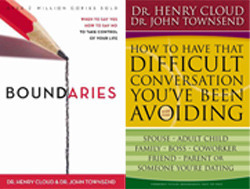 The Boundaries Action Set:
The Boundaries Action Set:
Do you find it challenging to express your wants to other people? Get practical solutions with the Boundaries Action Set. These two books are specifically designed to help you set healthy boundaries and effectively communicate your needs and wants in relationships. Both books include sample scripts that tell you what to say to other people when setting new boundaries.
Click on the links below for details and purchase options:
How to Have That Difficult Conversation You’ve Been Avoiding
Image courtesy of Stuart Miles at FreeDigitalPhotos.net
The post You Can’t Always Get What You Want – But You’d Better Try appeared first on Boundaries Books.
June 5, 2014
How to Say No With Gusto
 Jean used to believe that she would never learn how to say no and make it stick. But, as she sat at her kitchen table with a teacup in hand, she felt amazed. It was an unfamiliar sensation, but a pleasant one. Her mind wandered back to the events of the morning. Her eight-year-old son, Bryan, had begun the day with his usual waking-up shenanigans. He sulked and pouted his way to the breakfast table, announcing, “I’m not going to school — and no one’s going to make me!”
Jean used to believe that she would never learn how to say no and make it stick. But, as she sat at her kitchen table with a teacup in hand, she felt amazed. It was an unfamiliar sensation, but a pleasant one. Her mind wandered back to the events of the morning. Her eight-year-old son, Bryan, had begun the day with his usual waking-up shenanigans. He sulked and pouted his way to the breakfast table, announcing, “I’m not going to school — and no one’s going to make me!”
Normally Jean would have either tried to talk Bryan into attending school, or blown up at him in frustration. However, this morning was different. Jean simply said, “You’re right, Honey. No one can make you go to school. That has to be something you choose to do. However, if you don’t choose to go to school, you are choosing to stay in your room all day with no TV. But that’s something you’ll have to decide for yourself, like you did last week.”
Bryan hesitated in his tantrum. He was thinking about when Mom had made him stay in his room and miss dinner when he had refused to set the table. Finally, he said, “Well, I’ll go — but I don’t have to like it!”
“Absolutely,” Jean agreed. “You don’t have to like a lot of things like school. But I’m sure you’ve made the right choice.” She helped Bryan on with his jacket and watched him walk to the carpool ride outside.
Not ten minutes later, Jean had received a call from her husband, Jerry, who had driven to work early. “Honey,” he said. “I just found out I have a meeting after work. The last time I showed up late for dinner, there wasn’t any. Think you could save some this time?” Jean laughed. “Last time, you never called me to let me know. I really appreciate your telling me in advance. I’ll feed the kids, and you and I’ll eat together later.”
Jean thought to herself, “My son makes it to school, even with a cranky attitude. My husband calls me to inform me about schedule changes. I’m dreaming, aren’t I, Lord?”
Jean wasn’t dreaming. She was, for the first time in her life, experiencing the rewards of setting and maintaining clear boundaries in her life. A great deal of hard work and risk-taking had gone into them. Jean saw visible, demonstrable proof that her boundary work was bearing fruit in her life. Things were different. But how did she get from Point A (boundarylessness) to Point B (mature boundaries)? Can we measure our boundary development?
How to Say No: Step 1 – Practice Baby No’s
Growth in setting emotional boundaries must always be at a rate that takes into account your past injuries. Otherwise, you could fail massively before you have solid enough boundaries.
“This boundary teaching doesn’t work,” complained Frank in a therapy session.
“Why not?” I asked.
“Well, as soon as I understood that I don’t set good limits with people, I called my father the same day and gave him what for. Can you believe what he did? He hung up on me! This is great, just great. Boundaries have made things worse for me, instead of better.”
Frank is like the overeager child who is too impatient for training wheels on his new bicycle. It’s only several falls and skinned knees later that he begins to entertain the possibility that he skipped some steps in his training.
Here’s an idea to help you navigate this step. Ask your support group or your good friends if you could work on boundaries with them. They will show you their true value in their response to your truth-telling. Either they’ll warmly cheer you on in being able to disagree with and confront them, or they’ll resist you. Either way, you’ll learn something. A good supportive relationship cherishes the no of all parties involved. The members know that true intimacy is only built around the freedom to disagree: “He who conceals his hatred has lying lips” (Proverbs 10:18). Begin practicing your no with people who will honor it and love you for it.
How to Say No: Step 2 – Rejoice in the Guilty Feelings
As strange as it may seem, a sign that you’re becoming a boundaried person is often a sense of self-condemnation, a sense that you’ve transgressed some important rules in your limit setting. Many people experience intense critical self-judgment when they begin telling the truth about what is and isn’t their biblical responsibility. Why is that? Let’s look at the answer in terms of slavery and freedom.
Boundary-injured individuals are slaves. They struggle to make value-based decisions on their own, but they most often reflect the wishes of those around them. And even though they can be surrounded by supportive boundary lovers, they still experience trouble setting limits.
The culprit here is a weak conscience, or an overactive and unbiblically harsh internal judge. Though we need our internal “evaluator” to help us know right from wrong, many people carry around an extremely self-critical — and inaccurate — conscience. They feel that they are transgressing when they aren’t.
Because of this overactive judge, the boundary-injured individual often has great difficulty setting limits. Questions such as, “Aren’t you being too harsh?” and “How can you not attend the party? What a selfish thought!” are raised.
You can imagine the havoc when the struggler actually sets a limit or two, even a small one. The conscience moves into overdrive, as its unrealistic demands are being disobeyed. This rebellion against honest boundaries is a threat to the parental control of the conscience. It attacks the soul with vigor, hoping to beat the person into submitting again to its untruthful do’s and don’ts.
In a funny way, then, activating the hostile conscience is a sign of spiritual growth. A signal that you may be protesting unbiblical restraints. If the conscience were silent and providing no “how could you?” guilt-inducing messages, it might mean that you were remaining enslaved to the internal parent. That’s why we encourage you to rejoice in the guilt. It means you are moving ahead.
How to Say No: Step 3 – Practice Grown-Up No’s
Think for a minute about this question: Who is your number-one “boundary buster”? Who is the foremost person in your life with whom it’s difficult to set limits? More than one person may come to mind. This step deals with those extremely complicated, conflictual, frightening relationships. Straightening out these relationships is a major goal in becoming a boundaried person.
This step underscores the importance of making sure we’ve done our painstaking homework and practice before now. Setting important limits with significant people is the fruit of much work and maturing.
It’s important not to confuse our goals here. Often, Christians who have been boundary injured think that the objective is to set limits on those important areas, and get life stabilized again. They may be living for the day when “I can tell Mom no.” Or when “I can set limits on my husband’s drinking.” While these sorts of confrontations are very important, they aren’t the ultimate target of learning boundaries.
Our real target is maturity — the ability to love successfully and work successfully, the way God does. Boundary setting is a large part of maturing. We can’t really love until we have boundaries. Otherwise, we love out of compliance or guilt. And we can’t really be productive at work without boundaries, or we’re so busy following others’ agendas that we’re double-minded and unstable. The goal is to have a character structure that has boundaries and that can set limits on self and others at the appropriate times.
 This is just the beginning to a major transformation! Learn more about how to say no and really mean it by reading the bestselling book, Boundaries.
This is just the beginning to a major transformation! Learn more about how to say no and really mean it by reading the bestselling book, Boundaries.
Image courtesy of Stuart Miles at FreeDigitalPhotos.net
The post How to Say No With Gusto appeared first on Boundaries Books.
June 2, 2014
Why Good People Pick Bad Relationships
 “Just call him and tell him that it is over,” I (Dr. Cloud) said to Marsha. I had listened to her for months now about her dating relationship with Scott and how she could not stand some of his hurtful patterns. And I was getting both concerned and tired of her denial of the kind of person that he really was. I began to push her.
So she decided to do it. She called him and broke it off. As expected, he went crazy and showed up at her door begging for her to not go through with it. There were all sorts of promises of change and the usual things that people in denial say when threatened with loss of love. But she held her ground. At least for a day.
“Just call him and tell him that it is over,” I (Dr. Cloud) said to Marsha. I had listened to her for months now about her dating relationship with Scott and how she could not stand some of his hurtful patterns. And I was getting both concerned and tired of her denial of the kind of person that he really was. I began to push her.
So she decided to do it. She called him and broke it off. As expected, he went crazy and showed up at her door begging for her to not go through with it. There were all sorts of promises of change and the usual things that people in denial say when threatened with loss of love. But she held her ground. At least for a day.
Two days later, Marsha called and canceled her next appointment. I called her back and found out the truth. She had gone back to Scott and was ashamed to tell me. I told her to come in anyway so we could talk about it.
As Marsha talked, I felt for her. She described the depression and aloneness that she went into when she broke it off and held her ground. She felt as if she were in a black hole that she could not see out of, and she felt completely hopeless. It was really a dangerous state.
No one who knew Marsha would have suspected her inner agony. She was a strong person in the business world, a committed Christian, and a ministry leader in her church. Everyone loved her, and no one would have thought that she would put up with someone like Scott, or that she could be so devastated by breaking up with such a jerk. But the breakup had left her so sad that she could barely function.
As we worked on Marsha’s feelings, we found that there was a very deep part of her that felt very much alone and unloved, and breaking up with Scott was bringing out a deep aloneness that normally she did not experience. And, as we began to look at her history, she avoided experiencing this internal aloneness by dating men. Each time she would end one relationship, there would be another one, even though they would not be men that she would want to be with long-term. She just could not stand to be alone. And so, her fear of being alone kept her from having boundaries with bad relationships. She would rather give in to a bad relationship than have no relationship at all.
This is a key point about boundaries in dating. If you do any of the following, then you might be giving up boundaries because of a fear of being alone:
Putting up with behavior that is disrespectful
Giving in to things that are not in accord with your values
Settling for less than you know you really desire or need
Staying in a relationship that you know has passed its deadline
Going back into a relationship that you know should be over
Getting into a relationship that you know is not going anywhere
Smothering the person you are dating with excessive needs or control
And surely there are other signs as well. But the point is, your aloneness makes you get involved in relationships that you know are not going to last. It also keeps you from being alone long enough to grow into a person who does not have to be in a relationship in order to be happy. There is a very important rule in dating and romance: To be happy in a relationship, and to pick the kind of relationship that is going to be the kind you desire, you must be able to be happy without one.
If you must be dating or married in order to be happy, you are dependent, and you will never be happy with whatever person you find. The dependency will keep you from being selective enough to find the kind of person who will be good for you, or will keep you from being able to fully realize a relationship with a healthy person. If you are afraid of aloneness and abandonment, you cannot use the love of people who are truly there until you deal with your own fears.
So, aloneness must be cured first, and this is a good boundary for dating. Here is the boundary: In order to cure your fear of being alone, you need to put a boundary around your wish for a relationship. Cure that fear first, and then find a relationship. How do you cure your aloneness without a dating relationship?
First, strengthen your relationship with God. Make him your first priority so that you are not trying to get God needs met by a relationship with a person.
Second, strengthen your relationships with safe, healthy Christians. Make sure that you are not trying to get your people needs met by a dating relationship, or by God. Yes, you need God. But you also need people.
The best boundary against giving in to bad relationships, less-than-satisfactory relationships, or bad dynamics in a good relationship is your not needing that relationship. And that is going to come from being grounded in God, grounded in a support system, working out your issues, having a full life, and pursuing wholeness. If you are doing those things, you will not be subject to saying yes when you should be saying no.
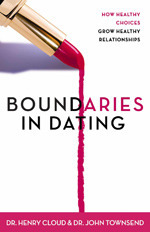 Special Deal: Save 40 – 45% off Boundaries in Dating
Special Deal: Save 40 – 45% off Boundaries in Dating
For more great advice to help you avoid bad situations and build a great relationship, read Boundaries in Dating. Click here to purchase and save over 40% off the paperback and ebook versions.
Image courtesy of Michael Marcol at FreeDigitalPhotos.net
The post Why Good People Pick Bad Relationships appeared first on Boundaries Books.
May 29, 2014
7 Tips to Set Summer Boundaries with Your Kids
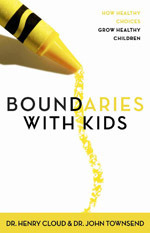 Summer is here and the kids are out of school. But, keeping your children occupied without losing your sanity can be especially vexing. Plus, if you have teens, all they want to do is sleep and stay out all night. What’s a parent to do?
Summer is here and the kids are out of school. But, keeping your children occupied without losing your sanity can be especially vexing. Plus, if you have teens, all they want to do is sleep and stay out all night. What’s a parent to do?
Set boundaries with kids! We’re here to help with seven tips for parents along with a special money-saving deal:
Buy “Boundaries With Kids” paperback for only $10.30 (save 31%)
Buy “Boundaries With Kids” ebook for only $5.99 (save 54%)
7 Tips to Set Summer Boundaries with Your Kids
It is scary how our kids can sense when we are weak and ready to give in to them. This can be especially true during the summer when kids are home all day and away from the structured environment of school. Without boundaries, kids learn how to beg, plead, argue, and rationalize to get out of their responsibilities. The later you start to enforce boundaries, the more energetically your children will resist. Here are seven tips to help you set important boundaries with your kids this summer:
1. Create summer structure
Develop boundaries that you need for your family and present them to your child, such as taking time each day to play on their own, reading a book, cleaning their room, going to bed on time, etc. You and your child both need to be a part of this process. The more you involve her in it, the more likely she is to take ownership of it and cooperate in her own growth. Invite her to partner with you, even though the plan is still going to be executed if she refuses.
2. Introduce new boundaries at a peaceful time.
Pick a good time and place when you and the child are getting along to discuss boundaries. Don’t raise the issue in the middle of a screaming match. That only serves to polarize things, and the child often feels forced to react more strongly against you to maintain separateness.
3. Take a “for” stance instead of an “against” stance.
Let kids know that setting boundaries isn’t about forcing her to do something or making their summer miserable. Tell her you see a problem that’s hurting her and negatively affecting the family. You want to deal with it because you love her, and you want to do it together with her.
4. Present boundaries using specific terms.
Make boundaries specific. For example, you could say, “Your yelling and running behavior around the house is a problem. It’s disruptive and it doesn’t seem to be getting better.”
5. Present the consequences.
When your boundaries aren’t respected, take a big breath and be direct. Don’t be afraid of the bad news. You aren’t hurting her; you’re freeing her from herself! Emphasize her freedom in meeting your expectations. She doesn’t have to do anything; she can choose to act as if you don’t exist. The key is that if she chooses to resist, the consequences will become a reality. Remember: You can’t control the behavior, but you can control the consequences. Stay in control of what is yours and encourage her freedom to choose.
6. Negotiate what is negotiable
Let the child have some input, within parameters, on expectations and consequences. Giving on something minor may pay off, as the child will feel less helpless and more involved in her destiny. Let her know that you may adjust something later if she proves herself for some period of time. Don’t budge on the non-negotiables, however. Drugs, alcohol, premarital sex, and violence are not gray areas.
Many times a child will protest, “You don’t do that, why should I?” This happens in many contexts, including bedtime, spending money, and free time. The reality is, however, that adults do have more freedom than kids, because they are more responsible. Responsibility brings freedom. Tell your child about that. Hold it out as an incentive to accept the boundaries. Growing up has its rewards.
7. Follow through during the summer.
Your child is on a learning curve, and learning takes many trials. Expect her not only to transgress the boundary, but also to protest the consequences many times. Be patient with yourself, too. Stay with it and follow through as consistently as you can. If you find you are not able to do that, seek help from mature friends who may be able to explore with you whether the problem is one of resources, abilities, character, or unrealistic expectations. Then you can make adjustments as needed during the summer break.
-–
 Get the help you need this summer to raise kids who take responsibility for their actions, attitudes, and emotions. Drs. Henry Cloud and John Townsend take you through the ins and outs of instilling the kind of character in your children that will help them lead balanced, productive, and fulfilling adult lives. Learn how to:
Get the help you need this summer to raise kids who take responsibility for their actions, attitudes, and emotions. Drs. Henry Cloud and John Townsend take you through the ins and outs of instilling the kind of character in your children that will help them lead balanced, productive, and fulfilling adult lives. Learn how to:
Set limits and still be a loving parent.
Bring control to a chaotic family life.
Define age-appropriate boundaries and consequences for your kids.
Buy “Boundaries With Kids” paperback for only $10.30 (save 31%)
Buy “Boundaries With Kids” ebook for only $5.99 (save 54%)
The post 7 Tips to Set Summer Boundaries with Your Kids appeared first on Boundaries Books.
May 26, 2014
How to Take a Boundaries Risk
 Great relationships are fulfilling.
Great relationships are fulfilling.
Great relationships involve risk.
You can’t have the first without the second.
Great relationships require that you be open to taking risks—risks of being misunderstood, of alienation, of someone being hurt by you as well. It doesn’t mean relationships aren’t worth the risks, for the good ones are. It is simply the price of the course. No pain, no gain.
The challenge is that people who have been burnt in a relationship often have trouble with risk. They get out of balance. Sometimes they insist on no risk and try to control the course of the relationship. This can actually be boring and unfulfilling. And sometimes they allow behavior that is unacceptable in the name of taking risks. In other words, they don’t quite know the difference between risks that are worth taking and risks that are not worth taking. In order to move beyond boundaries and prepare yourself for openness and vulnerability, you have to clarify which risks are—and are not—worth taking.
For example, Nick was a man who came from a harsh and controlling family. He had few choices as a boy and had adopted a compliant personality style to survive his childhood. He just toed the line to make it from day to day and never expressed his real thoughts and feelings. His compliance pattern worked for him, and he learned to channel his energies into being a business success. He worked great in authoritarian structures, where the boss was strict and rigid. But he felt dead inside, and he knew it was a problem.
As I (Dr. Townsend) worked with Nick, he became aware of how much legitimate personal power and control he had never had. As often happens, when he got in touch with those feelings, he went through a season of becoming controlling himself, sort of turning the tables. Actually, it was a way for him to separate himself enough from the controlling dad in his mind, to become more comfortable with his own power. But during this season, he was hard to live with. When his wife disagreed with him about a financial decision he made, for example, this normally easygoing guy said, “If you loved me, you would support and trust me.” In other words, he interpreted her freedom as a lack of love and as something that was not good for him.
But here is the reality: the problem is never the freedom. The problem is always the character of two people: yours and the person you love. Don’t make freedom the bad guy; instead, you must celebrate and protect it, because without it there is no love. But you get hurt either because the person was unloving, there was a miscommunication, or you allowed something you shouldn’t have, or because you wanted something that wasn’t possible. So that leads us to the question of risk. If risk is inevitable and even a good thing, you need to understand the difference between risks that are acceptable and those that are not.
How do you discern the difference between a hurtful result and a harmful result when you take a risk? Here’s the distinction: while hurt is the experience of something painful, it may not be damaging. But harm is different. Harm creates significant problems in the three primary areas of life:
1. Withdrawal from other relationships
If your experience in a relationship affects how you relate to other people in a significantly negative way, this is a sign of harm. For example, if you find yourself unable to reach out and let others in, isolate yourself from people, or withdraw from support, that is harm. The difficult relationship caused damage that impacts your other relationships, and you need time and attention to heal.
2. Personal decline
Your personal life encompasses everything that happens inside your skin: your behaviors, how you feel about yourself, your emotional well-being, and your habits. If the relational conflict results in any kind of sustained personal decline — for example, depression, significant weight change, or incapacitating self-doubt—that is harm.
3. Diminished performance
Performance has to do with the doing aspects of life, the tasks and activities. Your job, career, financial life, home organization, and time management are parts of the performance piece. Harm happens when you can no longer function at the same levels you did or find that you can start projects and tasks but can’t finish them. Often, a person will experience problems in energy, focus, creativity, or enjoyment of work.
Are you starting to see the difference between hurt and harm more clearly? Does it give you a better idea of the kinds of risks that routinely come with connection and the kinds of risks that should never be taken? Here are some additional examples to help make the difference crystal clear:
It is acceptable to have an argument, but not to be yelled at and treated with contempt.
It is acceptable to pick the wrong person, but not to let that person take over your life, thoughts, and values.
It is acceptable to open up to a person and feel bad if they become critical of you, but not to allow it to happen repeatedly.
It is acceptable to give up controlling the outcome of the relationship and where it will end up, but not to let the other person’s choices be the only choices.
When problems happen in a relationship, keep pushing through hurt, as long as you are committed to the relationship. But pay attention to when things cross the line into harm.
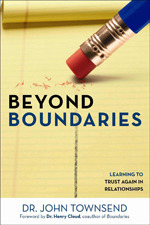 Beyond Boundaries by Dr. John Townsend is the must-read guide designed to help you reinstate appropriate closeness with someone who broke your trust, discern when true change has occurred, and restore former relationships to a healthy dynamic. Click here to read a sample chapter, watch a free video, and purchase your copy today.
Beyond Boundaries by Dr. John Townsend is the must-read guide designed to help you reinstate appropriate closeness with someone who broke your trust, discern when true change has occurred, and restore former relationships to a healthy dynamic. Click here to read a sample chapter, watch a free video, and purchase your copy today.
Image courtesy of jscreationzs at FreeDigitalPhotos.net
The post How to Take a Boundaries Risk appeared first on Boundaries Books.
May 22, 2014
Do You Give Yourself Permission to Fail?
 If there was anyone in Biblical history who learned from his failures, it was Peter. Consider this man who failed in his effort to walk on water (see Matthew 14:28 – 30), denied Jesus (see Luke 22:54–62) and suffered a rebuke from Paul regarding his treatment of Gentile Christians (see Galatians 2:11 – 13). Peter was outspoken, hotheaded and sometimes cowardly, but he became a founder of the church and an influential figure in church history.
If there was anyone in Biblical history who learned from his failures, it was Peter. Consider this man who failed in his effort to walk on water (see Matthew 14:28 – 30), denied Jesus (see Luke 22:54–62) and suffered a rebuke from Paul regarding his treatment of Gentile Christians (see Galatians 2:11 – 13). Peter was outspoken, hotheaded and sometimes cowardly, but he became a founder of the church and an influential figure in church history.
Like leaders of yesterday and today, we make mistakes. Whatever skills and talents we possess need to be refined. We can’t learn to be an authority and have expertise in an area if we don’t have the freedom to practice and learn. We need to give ourselves permission to fail. And that comes in part from doing what 2 Peter 3:18 says, “Grow in the grace and knowledge of our Lord and Savior Jesus Christ. To him be glory both now and forever!” Jesus will shepherd us through all of our failures.
No one ever became an expert in any area without trial and error. Whether it’s cooking, basketball, business, personal finance, teaching, Bible exegesis or child rearing, developing a skill requires practice. Practicing is an important aspect of realizing independence and adulthood.
We can fail and then learn from our experiences and try again. In this way, we begin to value the process more than the result. We see that growth is a journey that we are taking, walking hand in hand with God. When we fall down, as Peter did, we take God’s hand and get back up. If we keep doing that, like Peter, we will grow.
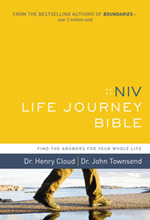 Find more insightful commentary from Drs. Henry Cloud and John Townsend, read the NIV Life Journey Bible, which combines the world’s most accessible Bible translation with exclusive boundaries teaching.
Find more insightful commentary from Drs. Henry Cloud and John Townsend, read the NIV Life Journey Bible, which combines the world’s most accessible Bible translation with exclusive boundaries teaching.
Image courtesy of Stuart Miles at FreeDigitalPhotos.net
The post Do You Give Yourself Permission to Fail? appeared first on Boundaries Books.

